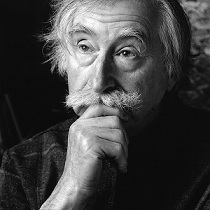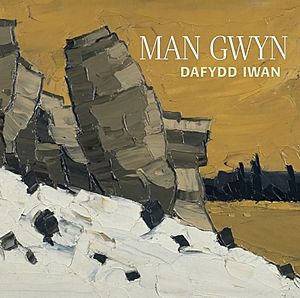Kyffin Williams facts for kids
Quick facts for kids
Sir
Kyffin Williams
|
|
|---|---|
 |
|
| Born |
John Williams
9 May 1918 Llangefni, Anglesey, Wales
|
| Died | 1 September 2006 (aged 88) Llanfairpwllgwyngyll, Anglesey, Wales
|
| Nationality | Welsh |
| Known for | Landscapes |
| Awards | RA (1974), OBE (1982), Knight Bachelor (1999) |
Sir Kyffin Williams (born John Williams, 9 May 1918 – 1 September 2006) was a famous Welsh landscape painter. He lived in Pwllfanogl, near Llanfairpwll, on the island of Anglesey in Wales. Many people consider Williams to be the most important Welsh artist of the 20th century.
Early Life and Training
Kyffin Williams was born in Llangefni, Anglesey. He was one of two sons in an old family from Anglesey. He went to schools in Anglesey and then to Shrewsbury School. While at Shrewsbury, he became ill with polio encephalitis. This led him to develop epilepsy. Williams later said that this illness was "my greatest fortune" because it helped him discover his love for art.
In 1937, he joined the 6th Battalion Royal Welch Fusiliers as a lieutenant. However, in 1941, he failed a British Army medical test because of his epilepsy. The doctor who examined him suggested he should follow his interest in art.
Williams then enrolled at London's Slade School of Fine Art in 1941. The school had moved to Oxford during the war. He won awards for his portrait paintings in his second and third years. After finishing his studies, he achieved his goal of teaching art. He became the senior art master at Highgate School in London, where he taught from 1944 to 1973.
Artistic Style and Inspiration
Williams mostly painted landscapes, but he was also good at portraits and even cartoons. He had a special way of painting. He would apply thick oil paint using a palette knife, which is a tool like a small trowel.
Even though he lived in London for many years, Wales was always in his mind. He would go back home to Wales during holidays to make study sketches. Then, he would take these sketches back to London to finish his paintings. His artworks often showed the Welsh landscape and farmlands.
In 1968, Williams received a Winston Churchill Fellowship. This allowed him to travel and paint in Y Wladfa, which is a Welsh settlement in Patagonia, South America. This trip was very important for his art. He created nearly 50 paintings of Patagonia. The different light in Patagonia also changed the colours he used in his paintings.

Later Life and Legacy
After retiring from Highgate School, Williams moved back to Anglesey. He spent the next 30 years painting. He also worked hard to support Welsh art schools and Welsh art in general.
Kyffin Williams never married. He passed away on 1 September 2006, at the age of 88. He had been suffering from health issues, including prostate cancer and lung cancer. It is believed his lung cancer might have been caused by working with lead-based paints. He was buried at St Mary's Church, Llanfair-yng-Nghornwy.
Many people admired Williams and his work. The famous singer Bryn Terfel, who collected Williams' paintings, said he was deeply saddened by his death. Terfel called Williams "Wales's foremost ambassador in the visual arts."
Williams had his first solo art show in London in 1949. His first exhibition of Patagonia paintings took place in 1971. In 2006, the Welsh singer James Dean Bradfield (from the band Manic Street Preachers) included a song called "Which Way to Kyffin" on his album The Great Western. This song was dedicated to Williams.
You can see many of Williams' works in a permanent exhibition at the Oriel Kyffin Williams Gallery. This gallery opened in 2008 at Oriel Ynys Môn in Llangefni, Anglesey. His paintings are also shown in many other galleries across Britain. He was the president of the Royal Cambrian Academy of Art and became a member of the Royal Academy of Arts in 1974.
Williams received several important awards for his contributions to the arts. In 1982, he was awarded the OBE. In 1995, he received the Glyndŵr Award for his outstanding work in Welsh arts. He was also knighted in 1999, which means he was given the title "Sir."
The Kyffin Williams Drawing Prize was started in 2009 to honour his work. The winning drawings from the 2018 prize were shown at the Oriel Kyffin Williams Gallery.
Williams was also a great storyteller and a talented writer. He published his autobiography in books like "Across the Straits" and "A Wider Sky."
The National Library of Wales was one of the first big institutions to buy his artwork in the 1940s. They continued to support him throughout his life. Because he was so grateful for their help, he left his papers and many of his artworks to the National Library. They now have probably the largest collection of his works.
Williams' paintings are held in many public collections. These include the Government Art Collection, the Arts Council Collection, and the National Museum of Wales.
In June 2018, a 50-minute BBC Television documentary about him was shown. It was called Kyffin Williams: The Man Who Painted Wales.
Williams' old home, a cottage called "Min y Môr" by the Menai Strait, is now a holiday rental.

